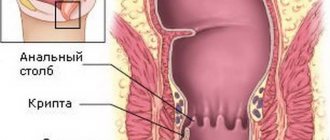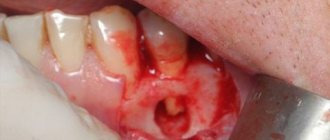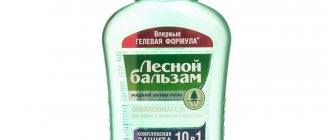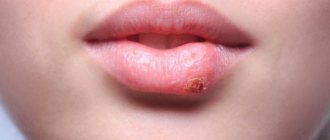Rectal fistula is one of the symptoms of the disease that no one will discuss with relatives. Many people are embarrassed to seek help from specialists with such problems. But paraproctitis is an insidious disease that causes not only moral suffering, but also physical pain. The disease rarely goes away without consequences. However, it can be overcome with the help of many medications. With rectal fistula, there is sharp pain in the anus and perineum. The disease is often accompanied by defecation disorders, chills and fever. Often with paraproctitis there is difficulty urinating. Typically, specialists suggest surgical intervention to relieve the patient of the disease. However, some practice treating rectal fistula without surgery.
Why does the disease occur?
Why does paraproctitis occur? There are many causes for this disease. Most often, the disease is provoked by factors that can reduce immunity. Among them it is worth highlighting:
- Poor nutrition.
- Sedentary, sedentary lifestyle.
- Acute or chronic form of infection of the digestive tract.
- Stool disorders: constipation, diarrhea.
- Chronic diseases.
Statistics show that the disease mainly affects women. The reason for this lies in wearing thongs, bikinis, and tight-fitting pants. Clothes made of thick fabric are especially dangerous. It can rub the skin in the perineal area. In addition, hypothermia can cause inflammation. After all, many women wear short skirts and thin tights in cold weather. In older people, paraproctitis usually occurs in a chronic form. Those at risk are those who suffered an acute form of the disease in their youth.
Paraproctitis after paraproctitis: photos, signs, causes of appearance
Photo of fistula
Most often, the cause of a fistula is a small hole in the walls of the anus, which forms after suffering from paraproctitis. For those who do not know, paraproctitis is an abscess that forms in the parorectal tissue.
In most cases, at the initial stage it proceeds hidden and people only learn about the presence of such a problem when it opens spontaneously. And since in this case the pus independently makes its way out, during this process a channel is formed, which we call a fistula.
Signs of a parapractical fistula:
- A person experiences a dull aching pain in the anal area. Some patients experience pain that prevents them from sitting in one place for a long time.
- Severe itching appears, which intensifies after defecation. As a rule, this happens due to the fact that some part of the feces, when exiting the anus, gets into the open wound and begins to irritate it even more.
- Irritation appears around the anus, which does not disappear even if the person takes very good care of his hygiene. Typically, tissue inflammation in this place is provoked by a fistula.
- Very often, such people experience an increase in body temperature. In some cases, just before the pus comes out, it can rise to 39 degrees.
- A bleeding wound appears on the anus, from which fluid is constantly released. The amount of liquid may vary. In some patients, the amount of it is negligible, while in other people it can be so much that they have to put panty liners on their underwear.
- Severe irritation may occur in the perineum. The cause of this problem is also the fluid that is released from the open wound. Since pathogenic bacteria come out along with it, they quickly provoke redness of the dermis, which is accompanied by a slight burning sensation.
initial stage
Treatment of rectal fistula without surgery is possible. In the early stages of this disease, the doctor usually prescribes warm compresses. They must be applied to the perineal area. In addition, experts recommend carrying out procedures such as warm baths and relieving enemas. Such measures can significantly improve the patient’s condition.
Antibiotics are usually prescribed for the treatment of rectal fistula. During treatment, patients are recommended to rest in bed.
Acute form
Treatment of rectal fistula without surgery in acute form is also allowed. However, such therapy has some peculiarities. As a rule, doctors recommend surgery, which involves opening the abscess. But, as practice shows, many patients do this at home using alternative medicine. In any case, after opening the abscess, cleaning the internal hole is required. If this is not done, then a relapse of this disease may occur, leading to the formation of another fistula.
Features of the disease
Even in a simple case, after eliminating the rectal fistula, a hole is formed in the anal canal. As a rule, it does not heal. In this case, a flowing fistula is formed. It is extremely rare for a scar to appear.
If any factor again provokes the development of paraproctitis, then an abscess may again form in the same canal. If there is a scar in this place, then an abscess may occur next to it. If the disease recurs, then its treatment should be the same as for the acute form.
Paraproctitis can occur even in infants. Treatment of rectal fistula with traditional methods in this case is unacceptable. The child should definitely be shown to doctors. It should be taken into account that surgical intervention is very difficult, since in young children the suppuration hole has a small diameter. This makes cleaning the canal much more difficult.
What is zinc ointment used for and how to use it?
- Composition and release form
- Mode of application
- Indications for use
- Contraindications
- Side effects
- Storage conditions
- Zinc ointment during pregnancy
- Zinc ointment for children
- What does zinc ointment help with?
- Analogs
- Price
- Reviews
Zinc ointment has proven itself as a drug in the treatment of many skin problems due to its effectiveness and affordable price. The instructions for use of zinc ointment discuss in detail the storage and use conditions of the drug, indications and contraindications.
But zinc liniment is a pharmaceutical drug, so before starting treatment with this medicine, you must visit a dermatologist for an accurate diagnosis of the disease and consultation on treatment with zinc ointment.
Composition and release form
Information about what the drug consists of, what substances it uses to treat and in what form it can be purchased is the key to a responsible attitude towards one’s health and helps to understand what the effect of treatment will be and how long it will last.
The main component of zinc ointment is zinc oxide. This chemical is in the form of a white or sand-colored powder. It is obtained through complex chemical reactions with zinc. Zinc oxide is used in various industrial sectors, but it is most widely used in medicine and the pharmaceutical industry.
The chemical property of zinc oxide to destroy protein explains its success in the treatment of dermatological diseases.
Related effects of this powder:
- antiseptic, bactericidal - helps cleanse the skin of pathogens, making the area almost sterile;
- anti-inflammatory – acting locally on the affected area of the skin, relieves inflammation, redness and swelling of tissues;
- adsorbent - absorbs pathological decay products, toxins formed on the surface of the skin;
- astringent - creates an invisible film at the treatment site, reducing the permeability of the skin to harmful substances, strengthening its structure.
For ease of use and to secure beneficial properties, zinc oxide powder is given the form of liniment. This is achieved by mixing the drug with white paraffin, obtaining a comfortable creamy structure.
The zinc preparation is produced in cans and tubes; everyone can choose a convenient form for themselves.
The container contains 20-30 grams of 10% ointment - that is, the package contains 2-3 grams of zinc oxide powder.
Mode of application
The ointment is applied 2-6 times a day, depending on the disease, to cleansed skin.
After applying the ointment, it is also contraindicated to apply additional substances (cosmetics, other medications) to these areas of the skin - this will neutralize the effect of the drug.
If the problems are of a point nature, it is possible to apply the medicine only to these areas of the skin, in small quantities, using a cotton swab.
The duration of treatment is determined by the attending physician; the course rarely takes less than 3 days and rarely lasts longer than 3 weeks.
Indications for use
The mild, broad effect of using zinc ointment allows it to be used for a wide variety of dermatological and cosmetic problems.
Dermatologists widely use the drug for:
- diaper rash on the skin of babies and the elderly;
- pyoderma (purulent skin lesion);
- bedsores (a common problem in bedridden patients);
- eczema;
- burns.
Good results are observed when treating herpetic ulcers with liniment - the wound dries out and the size of the vesicle decreases.
For some types of warts, zinc ointment has worked well.
It does not have antiviral properties, but its healing, antiseptic and enveloping effects give good results in the fight against warts.
The drug is indispensable for frequent traumatization of warts - when shaving - it prevents the introduction of bad microorganisms and protects the skin.
For teenagers suffering from acne and pimples, zinc ointment will be a real salvation.
Contraindications
The main contraindication to the use of zinc liniment is an allergy to one of the components of the drug: zinc oxide or paraffin. Before starting treatment, it is necessary to do a test to exclude allergic reactions - apply a thin layer of the drug to the inside of the forearm in an area of 1x1 cm and wait 15 minutes.
If there is no feeling of itching, burning on the skin, or redness in this area, it means there is no allergy to zinc ointment.
Side effects
Zinc liniment has a gentle effect, rarely causing undesirable consequences. Side effects may be associated with violation of the rules for using the medicine and the doctor’s instructions.
If you are allergic to the components of the ointment, if an individual sensitivity test has not been performed, itchy small rashes may occur at the treatment sites - hives, minor swelling.
Storage conditions
For proper treatment, achieving the desired effect and preventing adverse reactions, pharmaceutical drugs must be stored in the temperature and light conditions strictly specified by the manufacturer, avoiding the use of expired drugs.
Zinc ointment is stored in its original packaging, which protects from excess light, which negatively affects its components.
Storage temperature should be in the range of 12-25o Celsius. Storing the drug at lower temperatures makes it difficult to apply it to the skin - the drug becomes thick, exceeding the temperature destroys zinc oxide, changing its properties.
The original packaging of zinc liniment must indicate the date of manufacture of the medicine. Pharmacologists claim that if all storage rules are followed, the ointment does not lose its properties up to 8 years from the date of release, but it is not recommended to store it for longer than 4 years.
Expiration dates may vary depending on the manufacturer. On different packages you can see recommendations for storing the substance from 2 to 5 years. For comparison, the shelf life of oxolinic ointment (has a powerful antiviral effect, is used in the treatment of warts and in the prevention of ARVI) is strictly specified - 3 years from the date of release when stored in the refrigerator - the temperature should not exceed 10o.
Zinc ointment during pregnancy
The zinc-based preparation does not contain active substances that are absorbed into the blood through the skin. Zinc is an essential trace element for humans.
The combination of these factors makes zinc ointment approved for the treatment of pregnant and lactating women; there is no risk to the fetus.
The only important condition for prescribing the drug to a woman is that she does not have an allergic reaction.
Zinc ointment for children
Babies often face skin problems: diaper rash from diapers, prickly heat in the folds of the skin. A child's delicate skin is highly sensitive to sunlight - children often get sunburned. Almost every child manages to get chickenpox - he is bothered by itchy blisters and the mother is faced with the choice of a drug to treat her baby’s skin.
The therapeutic effects of the drug can help mother and child out of most childhood skin problems.
What does zinc ointment help with?
Coming to the end of the article, it is necessary to once again emphasize what skin problems are successfully treated with an ointment based on zinc oxide.
All minor damage to the skin with a violation of its integrity will heal faster if you use zinc ointment: teenage acne, eczema, dermatitis, minor burns, diaper rash, bedsores. Blisters caused by herpes will dry out, shrink, and stop causing discomfort after treating the skin with ointment.
Zinc ointment cannot affect the cause - the human papillomavirus, but can cure its manifestations on the skin - warts.
Destruction of the protein structure of the growth, protection of the skin from external factors lead to the rapid disappearance of warts, and treatment of injured tumors with the drug will prevent them from acquiring a malignant form.
Analogs
Zinc ointment has no similar drugs in its chemical composition.
In terms of therapeutic effects, the following drugs show similar results:
- Sinoflana ointment;
- Tsinocap;
- Undecine;
- Cynovit cream;
- Mycosporus;
- Reanimator cryo-gel.
These drugs may partially notice the effect of zinc ointment, but they have their own side effects, contraindications, and age restrictions, so before using them or replacing zinc ointment, consultation with a competent specialist is necessary.
Price
Zinc ointment is a very inexpensive drug that anyone can afford. This is a definite plus at current prices for medicines.
Prices vary depending on the city, manufacturer and pharmacy where zinc ointment is purchased.
Below is a table of prices for zinc ointment, 25g packaging, in some cities of Russia and Ukraine:
City
Price
| Moscow | 26-52 rub. |
| Saint Petersburg | 22-38 rub. |
| Novosibirsk | 25-38 rub. |
| Kazan | 19-39 rub. |
| Ekaterinburg | 16-28 rub. |
| Kyiv | 5-10 UAH. (15-30 rub.) |
Reviews
For quick and safe removal of papillomas, the best dermatologists and oncologists recommend the remedy for papillomas “Papilite”. This is a natural remedy that, having a gentle effect on papillomas, removes them without causing harm to the body. In addition, “Papilight” restores the body’s immune system, eliminating the reappearance of papillomas. The product has no contraindications, its effectiveness and safety have been proven by clinical studies at the Research Institute of Dermatology.
Find out more »
The problem called “what to put on a callus” sooner or later arises in every person. Moreover, it often has to be solved on an emergency basis, using what is at hand.
Calluses - functions and types
The formation of calluses is a way of protecting the skin from the penetration of pathogens into its deeper layers. Temporary growths appear where the skin is subjected to strong and prolonged mechanical impact. Most often, calluses form on the feet and hands.
In medicine, calluses are divided into two types - wet and dry. Wet ones are also called water ones, and if the situation has gone too far - bloody. Dry calluses are also divided into simply dry and core ones. In the latter case, callus formations develop until a growth is formed that goes deep into the skin.
Dry calluses are formed during prolonged, but mild, mechanical exposure. Wet calluses are a reaction of sensitive skin to intense friction. As a result, the epidermis loses connection with the dermis, that is, a traumatic detachment of the upper layer from the lower one is formed, and intercellular fluid is poured into the resulting space.
This is how the same bubble with liquid inside is formed. If pressure continues to be applied to it, the lower layers of skin are exposed, and their tissues are injured and damaged to the point of bleeding.
Treatment of fresh calluses
It is better to solve any problem as soon as it appears. As soon as you find a fresh, dry callus on your body, you need to treat it with iodine as quickly as possible.
The fact is that the dry version does not pose a risk of penetration of pathogenic microorganisms. The only problem is that a dry callus can turn into a wet callus with rupture of the bladder and the formation of an open wound. To prevent this from happening, it is necessary not only to disinfect the painful seal, but also to create all the conditions for its resorption. Iodine is the best solution for this task. Treatment with brilliant green is also acceptable. However, it disinfects and dries, but does not help relieve swelling and inflammation.
After the initial treatment of abrasions has been carried out, it is necessary to apply a bandage, gauze or cotton wool with ointment, which helps restore tissue, absorb intercellular fluid and relieve inflammation. Such means include:
- Super Antimozolin is an ointment containing lactic acid and urea;
- Balm Karavaev, capable of resolving internal calluses;
- Salipod is a patch based on salicylic acid;
- Levomikol and strepticidal ointment are good antiseptics.
There are also folk remedies for resolving dry calluses. Fresh formations can first be steamed in hot water and soda. After this, a layer of mashed uncooked potatoes is applied to the still slightly damp skin. It is covered with plastic wrap and wrapped with an elastic bandage or plaster. You need to keep this compress for at least an hour.
A compress made from steamed fresh birch leaves or an alcohol tincture of birch buds heals and absorbs calluses well.
Salt baths against rectal fistula
Treatment of rectal fistula with folk remedies allows you to cope with the disease much faster. As many reviews show, sitz baths with added salt can alleviate the patient’s condition and eliminate some symptoms. Such procedures cope well with inflammation and also help the pus to drain away.
This bath is very easy to prepare. First, you need to pour 5 liters of boiled water into the container. Baking soda, sea salt and regular salt should be dissolved in the liquid. It is enough to take a spoonful of each component. The finished solution should be filtered. This bath should be taken for 10 minutes. Treatment of rectal fistula with folk remedies should be carried out in courses. You need to do salt baths for 15 days, one procedure per day. After the baths, special ointments should be used. They are usually prescribed by a doctor.
Herbal baths
How else can you eliminate a rectal fistula? Symptoms, treatment, as well as recovery from the disease - all this causes a lot of negative emotions and discomfort. To alleviate the illness, you can take sitz baths, but not with a salt solution, but with a herbal decoction. You can prepare it at home.
As a rule, to treat rectal fistula, a decoction of St. John's wort, oak bark, calendula, bergenia, yarrow, calamus, shepherd's purse and other herbs is used. To prepare the product, you need from 50 to 60 grams of herbs. This amount of raw material must be poured with boiling water (1.5 liters) and placed on fire. The herbs need to be brought to a boil and simmer for 20 minutes. Now the product should infuse. This takes about 40 minutes. The finished broth should be thoroughly strained, then poured into a container of a suitable size and diluted with warm water (5 liters). These baths should be taken for 10–15 minutes.
Compresses and ointments
To treat a fistula on the gum, ointments, gels and other mixtures are used at home. One of the most effective creams is prepared from equal parts of tansy, calendula and dried yarrow. They are ground to a powder, and then a little Vishnevsky ointment is added to make a very dense, set mixture. Apply to the damaged area 3 times a day.
An ordinary mummy, taken in the amount of 10 tablets, will help with a fistula on the gum. Crush them, mix with a small chopped onion. Add 1 tbsp. l. unrefined oil and apply to the damaged area. Repeat 3 times a day.
A walnut will help at home for an unpleasant fistula on the gum: chop green fruits, boil, pour a glass of sunflower oil for 10 days. Add 2-3 tbsp to the resulting mixture. l. beeswax (or until desired consistency is achieved). Apply to the fistula 3 times a day.
Get rid of inflammation with an ointment made from 40 g of eucalyptus and 1 tbsp. l. sunflower oil. After a day, add 1 chopped onion to the mixture. You can hold it for 20 minutes. The drug has a pulling effect. A paste of aloe and kalanchoe is good at drawing out infection from a wound.
Anti-inflammatory herbal ointment: take 1 tbsp. l. chamomile, the same amount of calendula, crushed, mixed with 1 tsp. sea buckthorn oil. You can apply it to a fistula in the gum 2 times a day.
To properly apply the ointment application, use a small piece of gauze. Dip it in the composition, apply it to the pathological area, press it with your lip and try not to talk. After 20-30 minutes, remove the application.
At home, a fistula can be confused with other diseases, including a purulent abscess. To obtain an accurate analysis, it is important to consult a doctor, because damage to the roots of a tooth is a dangerous pathology that threatens many complications.
Bath recipes
Rectal fistula, which is recommended to be treated at home only under the supervision of a doctor, is a very unpleasant phenomenon. The following sitz baths can be used for therapy:
- 70 grams of ash must be poured with water (7 liters) and placed on fire. The product should be boiled for half an hour. After this remedy, the decoction must be filtered and cooled to a temperature of 35 to 37 °C. You should take a bath for about 25 minutes. The number of such procedures is not limited and depends on the degree of the disease.
- Two liters of milk must be brought to a boil. Next, add several medium-sized onions and 4 cloves of garlic to the container. You need to boil this product for 2 minutes and then cool slightly. Baths should be taken hot. In this case, the body should be wrapped in a blanket. You cannot stop the procedure until the milk has completely cooled down. The course lasts until complete recovery.
Microclysters
Treatment of rectal fistula without surgery using folk remedies is a difficult process that requires endurance and patience. The use of microenemas can increase the patient's chances of recovery. To carry out such procedures, a special bulb with a rubber tip is required. The tool must be properly cleaned before use. To avoid damaging the tissue, the tip should be lubricated with cream or vegetable oil. Here are some effective recipes:
- A spoonful of honey should be dissolved in 100 grams of water. After this you need to prepare an infusion of herbs. For this you will need chamomile, yarrow and sage. The mixture must be poured with 200 grams of boiling water. In a separate container you need to mix both products, taking 1 dessert spoon of each. This solution should sit for at least 30 minutes. Before going to bed, you can douche. After this, the procedure should be repeated, but using only an infusion of herbs of about 40 milliliters. In addition, it is recommended to drink 1/3 of this medicine.
- Raw potatoes must be thoroughly washed and grated along with the peel. The resulting mass should be carefully squeezed out. The resulting juice should be used for douching. A tablespoon of the product should be injected into the anus at night. The course is 10 days.
- For rectal fistula, a microenema with a solution prepared from fresh calendula flowers helps. First you need to prepare the product. You need to pour 20 grams of calendula flowers into a glass of boiling water. The product should sit well. This takes several hours. The finished infusion should be filtered and can be used for its intended purpose.
Treatment of fistula with folk remedies - Healthy lifestyle recipes
Ointment for all occasions Take pine resin, medical tar, butter, aloe leaf pulp, and flower honey in equal proportions. Place this mixture in a water bath and heat there, stirring until the mixture becomes homogeneous. If it turns out very thick, dilute with vodka. This ointment helps to cure any non-healing fistulas, bone tuberculosis, abscesses. You need to put it around the fistula, cover it with a sterile napkin, polyethylene and secure it with an adhesive plaster. (newspaper “Bulletin of Healthy Lifestyle” 2003, No. 3, p. 25)
Traditional treatment for fistula with cabbage A woman developed a fistula under her knee, for 2 months doctors prescribed various ointments, but they did not help, her leg hurt. A neighbor suggested an unusual folk recipe: tie a fresh cabbage leaf to the sore every day and walk with it all day. Do the procedure for 12 days in a row. On the 13th day, red dots should appear around the fistula. If they appear, it means the treatment was successful, everything will heal quickly. The woman began making cabbage compresses; within a day the leaf dried out and became transparent. And after the 12th procedure, red dots around the fistula were discovered under the sheet. Everything went smoothly. After 3 days there was no trace left of the fistula. (recipe from Healthy Lifestyle 2002, No. 3, p. 18, )
Fistula in a newborn - treatment with aloe and mumiyo at home. An umbilical fistula in a newborn child was cured with the following folk remedy. Dilute the mumiyo with boiled water to the color of strong tea leaves. Mix the mummy solution and aloe juice in equal parts. Moisten a bandage with this mixture and apply to the navel. (folk recipe from Healthy Lifestyle 2003, No. 9, p. 27)
Ligature fistula - treatment with infusion of aloe and honey at home. A man’s ligature fistula had not healed for 4.5 years; he turned to the readers of the newspaper “Vestnik ZOZH” to advise him on folk remedies to cure the fistula. I received a lot of advice. But the following folk recipe turned out to be very effective: tear off 12 leaves from the bottom of a 2-3 year old aloe, put it in the refrigerator for 10 days, rinse in boiled water and chop finely. Pour the crushed aloe into a jar, add fresh liquid honey there so that the aloe pieces are completely covered. Infuse the mixture for 6 days, shaking daily. Then strain the mixture, discard the aloe leaves, and take 1 tsp of the liquid. 3 times a day before meals. In addition to this treatment, the man also washed the ligature fistula daily with a furatsilin solution from a small syringe. After a month and a half of continuous treatment, the fistula began to actively heal. (recipe from Healthy Lifestyle 2004, No. 1, p. 27)
Traditional treatment of fistula after surgery for cancer A man was operated on for lung cancer. The postoperative fistula did not heal for a long time - it hurt, festered, the temperature rose, the patient lost 12 kg after the operation. After studying a lot of literature, we decided to treat the fistula with celandine. The man began to drink an infusion of this herb. My appetite returned immediately and my health improved. He drank in courses: he drinks for a month, rests for a week. The fistula has healed, the tumors are not growing. (recipe from Healthy Lifestyle 2004, No. 12, p. 26)
External fistula - onion and calendula ointment. Finely chop 200 g of onion, pour in 500 ml of hot rendered pork fat. Heat in a frying pan until the onion browns. Pour into a jar and cover for 8 hours. Pour 1 cup of calendula flowers into 500 ml of hot rendered pork fat. Keep at 60 degrees for two days. Apply bandages to the fistula with these ointments, alternating them. (2005, no. 11, pp. 18-19)
Bread and salt is a folk method for treating fistula. The man had 2 fistulas in the abdominal wall. I tried to treat fistulas at the clinic for three weeks, but to no avail. I decided to use folk remedies. I pressed as much salt into the crumb of black bread as possible. I made a cake, smeared it on one side with saliva and applied the same side to the fistula. The second fistula was not touched for comparison. .Changed the cake every other day. On the fourth day, the fistula cleared up and began to heal. I got rid of the other one using the same method. Soon there were no traces left, only the skin was whiter at first. (review from Healthy Lifestyle 2005, No. 11, p. 31)
Fistula on the coccyx - traditional treatment mumiyo. The woman repeatedly developed a fistula on her tailbone, lost her legs, and was unable to sit. They performed surgery several times, but the fistula on the tailbone opened again. Then the elderly doctor gave the patient a piece of mountain mumiyo the size of a match head - this was enough for a month's course - the woman made an aqueous solution of mumiyo and washed the fistula, making lotions. Three months later she carried out another course of treatment for the fistula. Since then, this sore has not bothered her. And now mumiyo can be bought without any problems at any pharmacy. (review from Healthy Lifestyle 2005, No. 24, p. 26)
Fistula on the leg - home treatment with oleoresin. A man used oleoresin to save his toe from amputation. The finger was black and had a fistula with an unpleasant odor. He applied softened resin to a rag and wrapped his finger in it. The fistula closed after 3 days. (review from Healthy Lifestyle 2006, No. 4, p. 31)
Homemade ointment for fistula After the operation, the man was left with a fistula. It was small, but blood was constantly oozing from it. At the hospital, his fistula was expanded, cleaned, and washed. And so several times, but to no avail. So they discharged me with a fistula that did not close. Every day by lunchtime the temperature rose, my whole body ached, sometimes the temperature jumped to 40 degrees and I had to call an ambulance. This went on for 8 months. In the summer, the patient moved to the village, where he began asking local residents for folk remedies for non-healing wounds and fistulas. He was advised to make an ointment from pine resin, wax, vegetable oil and butter. The man collected pine resin and prepared an ointment, adding more propolis. I soaked a bandage in the ointment, wrapped it around a match, and inserted the match into the wound before going to bed. The match went in almost completely. The next day the temperature did not rise. In the evening he performed the same procedure again, the Match only entered 3/4 of the way. The fistula gradually closed, and after a week it healed completely. Here is the ointment recipe: Take 1 tsp. crushed wax, propolis, resin, 2 tbsp. l. vegetable oil and 2 tbsp. l. (40-50 g) butter. Place everything in an enamel bowl and put on the lowest heat. Heat, stirring, until everything is dissolved. Immediately strain the hot mixture through 4 layers of gauze. (review from Healthy Lifestyle 2007, No. 19, p. 33)
Treatment of fistula with folk remedies. One of the most effective folk remedies for fistula is mumiyo. It must be taken once a day on an empty stomach for 28 days (1 course of treatment). In advanced cases, the second course should be administered after 10 days. Mumiyo should be dissolved in 50 ml of water, or preferably milk. The daily dose of mumiyo depends on the patient’s weight: up to 70 kg – 0.2 g, up to 80 kg – 0.3 g, up to 90 – 0.4 g, over 90 kg – 0.5 g. High-quality mumiyo dissolves completely in water. Simultaneously with oral administration, mumiyo is also used externally - make lotions by dissolving 3 g of mumiyo in 100 ml of water. For fistulas and any abscesses, it is useful to apply cakes made from comfrey root powder overnight. Comfrey stimulates the growth of healthy skin cells. Rinse the fistulas with very hot salt water (1 teaspoon of salt per 1 cup of water). Lubricate wounds with celandine juice 2-3 times a day (review from Healthy Lifestyle Healthy Lifestyle 2008, No. 19, p. 32-33)
Fistula in a child - treatment of fistula with dandelion tincture at home. The child had fistulas near the ear tragus: holes appeared, sometimes sticky transparent liquid oozed from them. Pharmacy ointments did not help - the holes did not heal. When I had a cold, the fluid became purulent and my ears hurt. Over time, a foul odor appeared from the fistulas. It was time for the girl to go to school; she had to somehow get rid of the fistula. A tincture of dandelion flowers in triple cologne came to the rescue. At first, the tincture was simply applied to the wounds. After 3-4 times the inflammation stopped, the fistulas almost healed. But after some time, the inflammation began again, purulent discharge began. Then the parents decided to pour dandelion tincture directly into the fistulas with a pipette. After three such procedures, the fistulas near the ears were completely healed, healed very quickly and did not open again. (HLS 2010, No. 9, p. 10)
Cabbage leaf for postoperative fistula. The woman underwent surgery, after which a fistula formed at the site of the suture. I turned to the surgeon, who said that I would have to live with the fistula. I read a recipe in the Healthy Lifestyle Bulletin that fistula can be treated with cabbage. The patient washed the cabbage leaf, lightly beat it until the juice appeared and applied it to the wound. After seven procedures, the fistula seemed to disappear, but the recipe said that it should be applied 12 times. The woman continued treatment. And after the eighth procedure, I saw on the removed piece of paper that the threads had been bunched up and sewn up due to carelessness during the operation. After the threads came out, the fistula healed, everything fell into place. (2012, no. 9, p. 31)
Ligature fistula does not close - what to do. After surgery to remove a hernia, a fistula formed. It has been bothering the woman for five years: it constantly festeres, and a lump the size of a chicken egg has formed. Surgeons believe that a new operation is needed. The patient contacted Vestnik ZOZH with the question “How to avoid surgery?” Candidate of Medicine answers. Sci. A. I. Vanin. In a patient, a ligature fistula is a fistula caused by the presence of an infected suture ligature (thread), which is tied during surgery on a transected vessel. Usually, a ligature fistula closes and heals after the festering threads have drained away. This did not happen for the patient. Therefore, she needs to do a fistulography - an X-ray examination of the fistula with contrast, to see if it is connected to the internal organs. Based on the results of the studies, the doctor will prescribe treatment for the fistula. For now, you need to wash the wound with a 1% dioxidine solution: inject the solution inside with a syringe without a needle and cover with a napkin soaked in the same solution. Secure with adhesive tape. Do the procedure every day for a week. If a lot of pus and fluid comes out, then rinse several times a day. Usually on the 3-4th day the fistula stops flowing. You can apply an oily solution of propolis or levomikol ointment. At the same time, take sumamed tablets - 0.5 g 1 time per day 1-2 hours after breakfast at the same time. Course 3 days. After this, take Complivit vitamins once a day for a month. From folk remedies - take 1 tsp. 3 times a day aloe honey syrup, the recipe for which is given above. A decoction of calendula flowers is also suitable for washing the fistula: 1 tbsp. l. for 1 cup boiling water. Add a few drops of tea tree oil to the warm broth. With the same decoction, apply compresses to the wound 1-2 times a day for 5-10 days. Take medications and folk remedies to boost your immunity. (HLS 2013, No. 12, p. 16)
Fat against rectal fistula
Badger and bear fat will help eliminate rectal fistula. Treatment without surgery is a long process. During therapy, you can use various alternative medicines. In addition to microenemas and sitz baths, you can use tampons. They should be soaked in fat and inserted into the anus at night.
If you do not have these ingredients, you can use fresh potato sticks. They are used like fat tampons. It is worth noting that potatoes are good at soothing irritation, and also heal and cover erosions and cracks located in the anal area.
Uses of olive oil
A fairly simple but effective recipe is to use olive oil, which is mixed in equal quantities with vodka. The resulting mixture should be wiped over the affected area three times a day. You also need to periodically tie a cabbage leaf to the fistula. After two weeks of this treatment complex, the desired result will be noticeable.
Using a special ointment
To heal fistulas in the vagina or rectum, a special ointment is used. To prepare it you need dried toadflax flowers and lard, water pepper herb, and oak bark.
The plant ingredients are thoroughly crushed, placed in a bowl, and poured with melted lard. The ratio of ingredients (fat to herbs) is 1:2. That is, for a two-hundred-gram glass of herbs, take two glasses of pork fat. The dishes along with this composition are placed in the oven and the heat is turned on low. They keep it for twelve hours. The resulting product is used as tampons. They are changed every four hours.
Tea Recipes
Treatment of rectal fistula without surgery can be carried out not only with the use of topical agents. To overcome the disease, you can drink various teas. Such remedies help cope with paraproctitis.
To prepare the drug you will need 100 grams of plantain leaves and marshmallow roots, as well as 75 grams of yarrow. All components need to be crushed and then mixed. In the evening, pour three tablespoons with 700 milliliters of boiling water. The product should sit overnight. In the morning, the finished infusion must be strained. It is recommended to drink 150 milliliters of this drug per day before meals. For greater effect, you need to take the product at least 4 times during the day. It is worth noting that the infusion allows you to cope with paraproctitis and, of course, with fistula.
Rectal fistula: treatment with St. John's wort and other herbs
This is another effective way to treat rectal fistula, as well as the disease that caused it. To prepare, take a glass of 50 milliliters
herbs such as St. John's wort, basil, Japanese sofa and celandine. You will also need birch leaves. You need several of these glasses.
All crushed ingredients must be mixed and then brewed with 1.2 liters of boiling water. The container with the product should be placed on the fire and brought to a boil. You need to cook the drug for a minute over low heat. Now the broth should stand for about an hour. The finished product should be filtered and taken between main meals, at least three times a day. Dosage – tablespoon.
Experts also recommend using an infusion of these herbs for microenemas. They can be done up to 4 times during the day. After such procedures, a tampon moistened with a decoction should be applied to the places of suppuration. This remedy will help quickly eliminate rectal fistula. Treatment without surgery using the methods described above allows you to recover faster from the disease.
Treatment
The first thing to do is to free the tissue from the source of infection. To do this, it is necessary to sanitize the oral cavity and eliminate carious lesions. If the canal has not yet formed, it must be opened in the dentist's office. Is it possible to pierce a fistula on the gum yourself? No, this is dangerous due to the spread of infection to adjacent areas of the gums. Only a doctor can open the tumor.
How does the opening of purulent inflammation occur? First, the doctor will take an x-ray to determine the extent of tissue damage and find the source of the infection. Then the dentist selects a treatment method:
- granuloma removal;
- cyst removal;
- improperly sealed canals.
If the fistula appears on the surface of the gum, it is opened from the outside. If the source of pus is located near the dental canals, the tooth is unsealed and the tissue is cleansed of pus. In difficult cases, the dentist removes the tooth completely to free the tissue from the pyogenic infection.
Can a fistula on the gum go away on its own? Even if a channel for the outflow of exudate appears, the cause of the pyogenic infection should be eliminated. The danger lies in a hidden source of inflammation, which may be located deep in the tissue. Even if everything goes away on the outside, the source of pathology remains inside. Therefore, the treatment must be completed, and only a dentist can help with this.
After autopsy, the patient should:
- rinse your mouth to remove pus;
- visit a physiotherapy room to eliminate the inflammatory process;
- use antibacterial ointments to treat the inflamed area of the gums.
In addition, the fistula is treated with antibiotics - take antibacterial and antimicrobial agents prescribed by a doctor.
How is the disease treated after tooth filling? The doctor treats the cavity, after eliminating the swelling and pus, installs a temporary filling, and a week later puts a permanent filling on the cured tooth.










